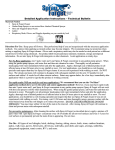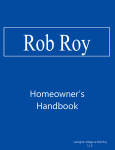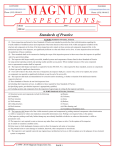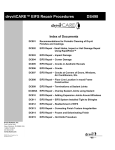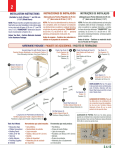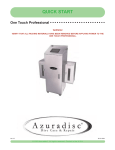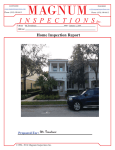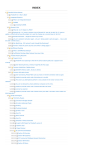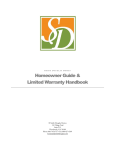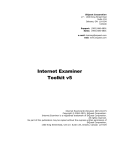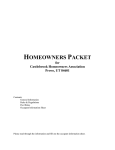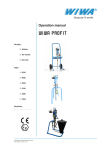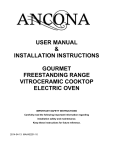Download Homeowner Manual
Transcript
Homeowner Manual WCI® Homeowner Manual Congratulations on your decision to purchase a new home from WCI. We share your excitement about your new residence and look forward to assisting you with any questions or services you may need. The WCI Homeowner Manual has been designed to assist you during the warranty period of your home and includes some helpful tips on key maintenance items. In addition, this manual provides a description of our limited warranty program. Please take time to review this material thoroughly. We are delighted to welcome you as part of the WCI family and are always ready to serve you. Sincerely, WCI Management Team (239) 498-8200 ® WCI Communities, Inc. Page 1 800.WCI.3545 WCI® Homeowner Manual Table of Contents Caring for Your Home ........................................................................................................................................... . 3 Reporting Warranty Items .................................................................................................................................... 5 Appliances................................................................................................................................................................... 7 Cabinets........................................................................................................................................................................ 8 Caulking .......................................................................................................................................................................10 Cementous Finish ..................................................................................................................................................... 11 Concrete Flatwork (Foundation, Lanais, Driveways, Walkways & Pavers) ........................................ 12 Concrete Masonry Units (Block) ........................................................................................................................ 17 Countertops................................................................................................................................................................ 18 Doors and Locks (Garage Overhead, Interior/Exterior Doors and Locks, Keys & Transmitters)................................................................................................................................................20 Drywall ........................................................................................................................................................................ 25 Flooring (Carpet, Tile & Wood) ......................................................................................................................... 27 Framing and Stairs................................................................................................................................................. 32 Grading, Irrigation and Landscaping ............................................................................................................... 33 Gutters and Downspouts ..................................................................................................................................... 37 Insulation..................................................................................................................................................................... 38 Mechanicals (Air Conditioning, Heat, Electrical, Smoke Detectors, Plumbing & Gas)....................39 Fixtures........................................................................................................................................................................43 Plumbing.....................................................................................................................................................................46 Gas Shut-Offs............................................................................................................................................................. 51 Mildew and Mold ..................................................................................................................................................... 52 Millwork ......................................................................................................................................................................54 Mirrors and Shower Enclosures ........................................................................................................................ 55 Paint and Stain .........................................................................................................................................................56 Roof ..............................................................................................................................................................................59 Swimming Pools ....................................................................................................................................................... 61 Termites ...................................................................................................................................................................... 62 Windows, Screens, and Patio Doors ................................................................................................................ 63 Page 2 800.WCI.3545 WCI® Homeowner Manual Caring for Your Home Cosmetic surface damage can occur during the move-in process or through daily activities. During your homeowner orientation, we confirmed that all surfaces were in good and acceptable condition. Any details that needed attention were listed on your orientation forms. After we correct any items noted during the homeowner orientation, repair of cosmetic surface damage is your responsibility. Our limited warranty excludes cosmetic damage to items such as: • • • • • • • • • • Sinks, tubs, and plumbing fixtures Countertops and cabinet doors Light fixtures, mirrors, and glass Windows and screens Tile, carpet, and wood flooring Doors, trim, and hardware Paint and drywall Finish on appliances Screen enclosures Finish on pavers and pool Homeowner Use and Maintenance Guidelines Periodic maintenance is necessary because of normal wear and tear, the inherent characteristics of the materials used in your home, and normal service required by the mechanical systems. Natural fluctuations in temperature and humidity also affect your home, resulting in maintenance items. Many times a minor adjustment or repair done immediately saves a more serious, timeconsuming, and sometimes costly repair later. Note also that neglect of routine maintenance can void applicable limited warranty coverage on all or part of your home. The attention provided by each homeowner contributes significantly to the overall desirability of the community. Please take time to read the literature provided by the manufacturers of consumer products and other items in your home. The information contained in that material is not repeated here. Although much of the information may be familiar to you, some points may differ significantly from homes you have had in the past. We make every effort to keep our information current and accurate. However, if any detail in our discussion conflicts with the manufacturer’s recommendations, you should follow the manufacturer’s recommendations. Activate specific manufacturer’s warranties by completing and mailing any registration cards included with their materials. In some cases, manufacturer’s warranties may extend beyond the first year and it is in your best interest to be apprised of such coverage. Page 3 800.WCI.3545 WCI® Homeowner Manual WCI Limited Warranty Guidelines While we strive to build a defect-free home, we are realistic enough to know that we may make mistakes or that something in the home may not perform as intended. When either occurs, we will make necessary corrections so the item meets our warranty guidelines. In support of this commitment, WCI provides you with a Limited Warranty. In addition to the information contained in the Limited Warranty itself, this manual includes details about material and workmanship standards, which may differ depending on the type of residence you purchase. We Sometimes Say No With a product as complex as a home, different viewpoints regarding which tasks are homeowner maintenance responsibilities and which are WCI warranty responsibilities are possible. If you request warranty service on a maintenance item, we will explain to you the steps you should take to care for the item. We are available to answer your home-care questions during and after your Limited Warranty Period. Providing normal maintenance for your home is your responsibility. Pets WCI respects the pets that many Homeowners count as members of their households. To prevent the possibility of an animal getting injured or lost, we ask that you restrict all animals to a comfortable location during any warranty visit, whether for inspection or warranty work. This policy is also for the protection of our employees and trade personnel. We have instructed WCI and trade personnel to reschedule the appointment if pets have access to the work area. Your Belongings In all work that we perform for our Homeowners we are concerned that their personal belongings be protected. When warranty work is needed in your home, we ask that you remove vulnerable items or items that might make performing the repair difficult. WCI and trade personnel will reschedule the repair appointment rather than risk damaging your belongings. Surfaces We expect all personnel who work in your home to arrive with appropriate materials to cover the work area, protecting it from damage and catching the dust or scraps from the work being performed. Similarly, all personnel should clean up the work area, removing whatever excess materials they brought in. Signatures on Work Orders Signing a work order acknowledges that a technician worked in your home on the date shown and with regard to the items listed. It does not negate any of your rights under the warranty nor does it release us from any confirmed warranty obligation. If you prefer not to sign the work order, the technician will note that, sign the work order and return it to us for our records. Page 4 800.WCI.3545 WCI® Homeowner Manual Reporting Warranty Items Service Processing Procedures You can help us to serve you better by providing complete information, including: • Name, address, and phone numbers where you can be reached during business hours. • A complete description of the problem, for example, “Guest bedroom—door does not lock properly,” rather than “door problem.” When we receive a warranty service request or a call to our Customer Care Help Desk, we may contact you for an inspection appointment. Warranty inspection appointments are available Monday through Friday, 8 a.m. to 4 p.m. We may need to inspect the items listed in your written request or phone call to confirm warranty coverage and determine appropriate action. ® If a trade contractor or a WCI employee is required to complete repairs, we issue a warranty work order and the repair technician contacts you to schedule the work. Warranty work appointments are available Monday through Friday, 8 a.m. to 4 p.m. It is our intention to complete warranty work orders within ten (10) business days of the inspection unless you are unavailable for access. If a back-ordered part or similar circumstance causes a delay, we will let you know. If the item is home maintenance, we will review the maintenance steps with you and offer whatever informational assistance we can. WCI does not provide routine home maintenance. Reporting Procedures All service requests should be made to Customer Care at 1-800-924-3545. The office is open Monday – Friday 8am – 5pm. Emergency service is also available if necessary, please see below for Emergency Service Criteria. Emergency Service As defined by the Limited Warranty, “emergency” includes situations such as: •Total loss of heat •Total loss of air conditioning • Total loss of electricity. (Check with the utility company before contacting WCI or electrician.) •Total loss of water. (Check with the water department to be certain the problem is not a general outage in the area.) •Plumbing leak that requires the entire water supply to be shut off. •Roof leak. While we agree with homeowners that a roof leak is indeed an emergency, the reality is that repairs cannot safely or effectively be performed while the roof is wet. During business hours, contact our office or the Customer Care Help Desk with the information. Take appropriate steps to mitigate damage and we will follow up when conditions make repairs possible. •Gas leak. (Contact your utility company or plumber if the leak is at the furnace or water heater supply lines.) Page 5 800.WCI.3545 WCI® Homeowner Manual WCI’s Customer Care Help Desk available 24-hours-a-day: 1-800-924-3545 (WCI) Appliance Warranties The manufacturers of the appliances will work directly with you if any repairs are needed for these products. Customer service phone numbers are listed in the use and care materials for each appliance. Be prepared to provide the model and serial number of the item and the closing date on your home. Appliance warranties are generally for one year; refer to the literature provided by the manufacturer for complete information. Storm Damage or Other Natural Disaster Contact your homeowner’s insurance agent immediately. Contain damage as much as possible without endangering yourself. In extreme situations, such as a disaster, photograph the damage. Page 6 800.WCI.3545 WCI® Homeowner Manual Appliances Appliances are warranted through the manufacturer. Read and follow all manufacturers’ instructions for the use and maintenance of each appliance in your home and keep them available for reference. Manufacturer’s Service If a problem arises with an appliance, call the customer service number listed in the manufacturer’s warranty. When reporting warranty items to the appliance manufacturer, be prepared to supply the following details: • • • Date of purchase (your closing date) Serial and model numbers, found on a metal plate or sticker on the side or bottom of each appliance Description of the problem WCI® Performance Standards Appliances We confirm that all appliance surfaces are in acceptable condition during your homeowner orientation. Any damage including scratches or dents must be documented at that time. WCI is not responsible for any loss or damages that may result from faulty or defective appliances. Page 7 800.WCI.3545 WCI® Homeowner Manual Cabinets Homeowner Use and Maintenance Guidelines Wood cabinets will show variations of grain, color and knots. Certain shades, such as natural and whitewashes, are quite transparent and provide little or no coverage of the variations in the grain. Darker stains provide more coverage of the grain due to the presence of more pigment in the stain. Pickling or white-wash finishes on a cabinet may take on color characteristics either more pink or yellow depending on the other colors surrounding the cabinet, such as flooring, wall color,countertop color and the amount of light, either natural or artificial, on the cabinet. Cabinets with laminate/thermofoil doors and exteriors are designed with a resistant surface for easy cleaning. When using the self clean on your oven, open the cabinet doors that surround it to release the heat. The self cleaning ovens reach high temperature that can cause the cabinets to delaminate. See your manufacturer’s brochure for details. WCI® Performance Standards Cabinet Door or Handles Not Level. Doors or Drawers Not Operating Properly. Cabinets should operate properly under normal use. Doors, door fronts and handle should be level and even. Homeowner Responsibility: Homeowner will not suspend heavy weight to doors or drawers. WCI Responsibility: WCI will ensure doors and drawers are level at the time of homeowner orientation. WCI will adjust one time during the Limited Warranty Period. Cabinet Separations Gaps between cabinets and the ceiling or cabinets and the walls or cabinets and cabinets or crown moldings, less than 1/8” are considered normal. The gaps will be filled with caulk. Homeowner Responsibility: None WCI Responsibility: WCI will correct gaps between cabinets and the ceiling or cabinets and the walls or cabinets and cabinets by caulking or other means if the gap exceeds 1/8" (locations behind appliances are excluded from this repair). Page 8 800.WCI.3545 WCI® Homeowner Manual Readily Noticeable Variations in Wood Grain and Color on Cabinets. Readily noticeable variations in wood grain and color are expected in all style selections. Homeowner Responsibility: None WCI Responsibility: None Scratches and Indentations WCI confirms that all cabinets are in acceptable condition during the homeowner orientation. Homeowner Responsibility: None WCI Responsibility: None Warping Doors or drawer fronts should not warp in excess of 1/4" within 24". Homeowner Responsibility: None WCI Responsibility: If doors or drawer fronts warp in excess of 1/4" within 24", WCI will correct this by adjustment or replace under the Limited Warranty Period at WCI’s discretion. Page 9 800.WCI.3545 WCI® Homeowner Manual Caulking Homeowner Use and Maintenance Guidelines Time and weather will shrink and dry caulking so that it no longer provides a good seal. As routine maintenance, check the caulking and make needed repairs. WCI® Performance Standards During the homeowner orientation we confirm that appropriate areas are adequately caulked. • Bathroom sinks • Bathroom wall tile • Cabinets • Countertops • Plumbing fixtures • Sliding glass doors • Stairs • Tubs and showers • Windows • Wood trim Homeowner Responsibility: Caulking is a maintenance item and should be done annually. WCI Responsibility: WCI will touch up caulking one time during your Limited Warranty Period. Page 10 800.WCI.3545 WCI® Homeowner Manual Cementitious Finish Homeowner Use and Maintenance Guidelines A cementitious finish is a durable and low-maintenance finish for a home’s exterior. WCI® Performance Standards Cracking Occurs in Exterior Cementitious Finish Wall and Lanai Surfaces. Cracks are not unusual in exterior cementitious finish wall and lanai surfaces. Cracks greater than 1/8" in width will be repaired Homeowner Responsibility: Sealing, caulking or waterproofing cementitious finish cracks is the Homeowner’s responsibility. WCI Responsibility: WCI will surface repair cracks exceeding 1/8" in width, one time only during the Limited Warranty Period. If a repair is needed, there will be color variation when painted. Efflorescence Efflorescence is the white chalky deposit that can appear on the surface of a masonry product. This is caused by water dissolving salts found naturally in the material. As the water evaporates, it leaves behind the salt. This is not a defect but rather, an aesthetic concern. Homeowner Responsibility: Remove efflorescence by cleaning with a mild detergent or a trisodium phosphate solution (TSP) and water may be needed. TSP is available at hardware or home improvement stores. WCI Responsibility: None Page 11 800.WCI.3545 WCI® Homeowner Manual Concrete Flatwork (Foundation, Lanais, Driveways, Walkways and Pavers) Homeowner Use and Maintenance Guidelines By maintaining good drainage, you protect your home’s foundation and the concrete flatwork. These are not a structural (load-bearing) element of the home and are excluded from coverage by the structural warranty. Cleaning We recommend sweeping for keeping exterior concrete clean. If washing is necessary, do this when temperatures are moderate. Repeated cleaning of the garage floor by hosing can increase soil movement by allowing water to penetrate any existing cracks. We recommend sweeping to clean the garage floor. This will also help to reduce moisture under the slab, which may attract termites. Cracks A concrete slab shrinks as it cures. Some of this shrinkage shows up as cracks. Cracking of concrete flatwork also results from temperature changes that cause expansion and contraction. During the summer, moisture finds its way under the concrete along the edges or through cracks in the surface. Maintaining drainage away from all concrete slabs will minimize cracking from this cause. As cracks occur, seal them with a waterproof concrete caulk (available at hardware or home improvement stores) to prevent moisture from penetrating to the soil beneath. WCI® Performance Standards Color Concrete slabs vary in color. No correction is provided for this condition. If an area is repaired, the new concrete will not match the existing. Homeowner Responsibility: None WCI Responsibility: None Page 12 800.WCI.3545 WCI® Homeowner Manual Cracks If concrete cracks reach 1/4" in width or vertical displacement, WCI will patch or repair them one time during the Limited Warranty Period for single family, non-condominium residences and as required under condominium warranties, unless such cracks are cosmetic in nature. Subsequently, concrete slab maintenance is Homeowner’s responsibility. The patch or repair will not match the existing concrete. Homeowner Responsibility: The Homeowner will be responsible for repair of any painted or sealed surface added to the driveway. WCI Responsibility: WCI will seal cracks that reach 1/4" in width or vertical displacement one time during the Limited Warranty Period. WCI is not responsible for color variation. Level Floors Concrete floors in the habitable areas of the home will be level to within 1/4" within any 32" measurement with the exception of an area specifically designed to slope toward a floor drain. Homeowner Responsibility: None WCI Responsibility: WCI will take corrective action as required to meet the Performance Standard. Settling or Heaving WCI will repair slabs that settle or heave in excess of 2" or if such movement results in negative drainage (toward the house) or hazardous vertical displacement. Homeowner Responsibility: None WCI Responsibility: WCI will take corrective action as required to meet the Performance Standard. Spalling or Chipping Causes of spalling include repeated hosing of concrete for cleaning or chemicals, such as fertilizer. Homeowner Responsibility: Repair of spalling is a home maintenance task. WCI Responsibility: WCI will seal cracks that reach 1/4" in width or vertical displacement one time during the Limited Warranty Period. WCI will take corrective action to repair or replace defective concrete surfaces. WCI is not responsible for deterioration caused by salt, chemicals, mechanical implements and factors not under WCI’s control. Unless otherwise specified, WCI is not responsible for roof water run-off onto patios, walkways or driveways. Page 13 800.WCI.3545 WCI® Homeowner Manual Standing Water Water should drain from all outdoor lanais, stoops and steps. Minor water standing after a rain on all lanais and stoops for a short period, 24 hours or less, is a possibility and is acceptable. Homeowner Responsibility: None WCI Responsibility: WCI will provide proper drainage of steps and stoops. Cracks in Concrete Slab – On Grade Floors with Finish Flooring Cracks which rupture the finish flooring material will be repaired. Homeowner Responsibility: None WCI Responsibility: WCI will repair cracks in concrete slab on grade floors, during the Limited Warranty Period, so they are not readily apparent and replace any flooring that is damaged in the repair. Foundation Homeowner Use and Maintenance Guidelines Your foundation is concrete with steel reinforcement. Cracks Surface cracks can develop in the concrete and are not detrimental to the structural integrity of your home. WCI® Performance Standards Cracks Shrinkage or backfill cracks are not unusual in foundation systems. Homeowner Responsibility: None WCI Responsibility: WCI will repair cracks that exceed 1/8" in width. Page 14 800.WCI.3545 WCI® Homeowner Manual Cracks in Concrete Slab – On Grade Floors with Finish Flooring Cracks which rupture the finish flooring material will be repaired. Homeowner Responsibility: None WCI Responsibility: WCI will repair cracks in concrete slab on grade floors, so they are not readily apparent and replace any flooring that is damaged in repair. Pavers Homeowner Use and Maintenance Guidelines A paver is a masonry unit that can be used as a surface upon which you may drive or walk. Cleaning Pavers are a porous material and will stain. Some surface stains may be cleaned with a light soapy water mix. However, stains such as oil from a leaking car cannot be removed. Efflorescence Efflorescence is the white chalky deposit that can appear on the surface of the paver. This is caused by water dissolving salts found naturally in the material. As the water evaporates, it leaves behind the salt. This is not a defect but rather, an aesthetic concern. Homeowner Responsibility: Remove efflorescence by cleaning with a mild detergent or a trisodium phosphate solution (TSP) and water may be needed. TSP is available at hardware or home improvement stores. WCI Responsibility: None Paver Base Material The material under your pavers will wash away if exposed to enough water. Heavy, continuous water on your pavers may cause certain areas to settle more than other areas. Sealing Your Pavers Sealing your pavers is your decision and responsibility. Once the pavers are sealed, ongoing maintenance of that seal is necessary and Limited Warranty coverage on pavers that have been sealed is voided. Page 15 800.WCI.3545 WCI® Homeowner Manual WCI® Performance Standards During the homeowner orientation we confirm that pavers are in acceptable condition. We will replace cracked, badly chipped, or stained pavers at that time. WCI is not responsible for variations in colors. Paver colors will vary. Chips and Cracks Pavers will chip or crack if hit with a sharp object or a strong blow. Homeowner Responsibility: Avoid dropping sharp objects onto pavers. WCI Responsibility: WCI will replace broken or chipped pavers at time of homeowner orientation. Chipped, cracked, or broken pavers are the responsibility of the homeowner after homeowner orientation. Color Paver bricks vary slightly in color. No correction is provided for this condition. Homeowner Responsibility: None WCI Responsibility: None Settling Expect slight settling with your pavers. Pavers may settle up to 1" in a 24" radius. Homeowner Responsibility: Keep running water off pavers as much as possible. WCI Responsibility: WCI will recompact areas settled that exceed one inch. Weeds and Grass Over time weeds and grass may grow in the cracks of your pavers. WCI is not responsible for removing or killing weeds and grass. Homeowner Responsibility: Spray cracks of pavers with a weed and grass killing spray. Spray a small test area to be sure the chemical does not damage or stain the pavers. WCI Responsibility: None Page 16 800.WCI.3545 WCI® Homeowner Manual Concrete Masonry Unit (Concrete Block) Homeowner Use and Maintenance Guidelines Concrete masonry units (CMUs) are widely used for residential homes. CMUs are a mixture of water, Portland cement and aggregate shaped in the form of a block. CMUs are durable, fire resistant, termite resistant, and energy efficient. WCI® Performance Standards Tolerances CMUs will be installed plumb and level to a tolerance of 1/2" in a 10-foot span. Homeowner Responsibility: None WCI Responsibility: WCI will deliver a wall system that is code compliant and within WCI tolerance standards. Cracks Cracks greater than 1/4" in the CMU are considered structural. WCI Responsibility: WCI will repair structural CMU cracks – provided that the homeowner did not make any modifications, such as adding a pool or additional landscaping close to home. Page 17 800.WCI.3545 WCI® Homeowner Manual Countertops Homeowner Use and Maintenance Guidelines During your homeowner orientation we confirm that all countertops are in acceptable condition. WCI will repair noticeable surface damage such as chips, cracks, and scratches noted on the homeowner orientation. Repair of surface damage that occurs during or after closing is Homeowner’s maintenance responsibility. Edges should be smooth and even. Where backsplash joints occur at corners, the top edges should be even within 1/16". Granite Granite is a natural product and will include variations. The beauty of natural stone is unique with each stone. Please be aware that natural stone will vary in color, shading and veining from the samples you selected from the Design Studio. Each piece will be different. Veins and fissures are random and are a natural characteristic of the stone, and are not considered a defect. Granite is a porous material. To help granite from staining, accumulation fungus and forming bacteria, it is recommended that granite be sealed by a qualified contractor once a year. If spills occur, wipe immediately to decrease chances of permanent staining. Sealing annually would be at the Homeowner’s expense after closing. Solid Surface Solid surface countertops will have one or more discernible seams. Solid surface tops should be installed without any sag and will be attached firmly to the cabinets. Bar areas with solid surface tops may experience slight movement. This is considered normal and will not be corrected. Homeowner Responsibility: Homeowner should not clean countertops with an abrasive cleaner or place hot cookware on the surfaces. Homeowner should always use a cutting board to avoid scratching. Homeowner will caulk corners of solid surface areas once a year with a clear silicone caulk. WCI Responsibility: WCI will repair or caulk any gap at seams or differential at other joints. Page 18 800.WCI.3545 WCI® Homeowner Manual Marble - Including Cultured and Manufactured Cultured marble is a man-made product. Each pouring will produce color variations. Shading and vein patterns can range from heavy to fine. Lighting may also cause some difference in appearance. Cultured marble installed in your home will NOT be an exact match to the cultured marble in the models or in the Design Studio samples. Homeowner Responsibility: None WCI Responsibility: WCI will install marble, including cultured and manufactured, to the above performance standards. Separation from wall Separation of countertops at walls and the backsplash are the result of normal shrinkage of materials or house settlement. Homeowner Responsibility: Homeowner is responsible for caulking so that moisture does not reach the wood under the laminates to prevent warping. WCI Responsibility: WCI will correct separations by caulking once during Limited Warranty Period. Chips or Gouges in Granite, Solid Surface and Marble, Including Cultured and Manufactured, Countertops. Rough Edges or Uneven Edges. Countertops should be installed without chips or gouges. Edges should be smooth and even. Homeowner Responsibility: Have a qualified contractor seal granite once a year to avoid staining, fungus accumulation, and bacteria formation. WCI Responsibility: WCI will repair only if noted on the Homeowner Orientation list. Page 19 800.WCI.3545 WCI® Homeowner Manual Doors and Locks (Garage Overhead, Interior/Exterior Doors and Locks, Keys & Transmitters) Homeowner Use and Maintenance Guidelines The doors installed in your home are made of various materials such as wood, fiberglass and metal. These materials have natural characteristics that may cause warpage and shrinkage. Bifold Doors Interior bifolds sometimes stick or warp due to weather conditions. Apply a silicone lubricant to the tracks to minimize this inconvenience. Exterior Finish To ensure longer life for your exterior wood doors, plan to refinish them at least once a year. Stained exterior doors with clear finishes tend to weather faster than painted doors. Reseal stained exterior doors whenever the finish begins cracking or crazing. Failure to Latch If a door will not latch because of minor settling, you can correct this by making a new opening in the jamb for the latch plate (remortising) and raising or lowering the plate accordingly. Hinges You can remedy a squeaky door hinge by removing the hinge pin and applying a silicone lubricant to it. Avoid using oil. Graphite works well as a lubricant but can create a gray smudge on the door or floor covering beneath the hinge if too much is applied. Locks Lubricate door locks with graphite or other waterproof lubricant. Avoid oil. Shrinkage Use putty, filler, or latex caulk to fill any minor separations that develop at mitered joints in door trim. Follow with painting. Panels of wood doors shrink and expand in response to changes in temperature and humidity. Touching up the paint or stain on unfinished exposed areas is the Homeowner’s maintenance responsibility. Sticking The most common cause of a sticking door is the natural expansion of lumber due to changes in humidity. When sticking is due to swelling during a damp season, do not plane the door unless it continues to stick after the weather changes. Page 20 800.WCI.3545 WCI® Homeowner Manual Warping If a door warps slightly, keeping it closed as much as possible often returns it to normal. Weather Stripping Weather stripping and exterior door thresholds occasionally require adjustment or replacement. WCI® Performance Standards During the orientation we confirm that all doors/weather stripping are in acceptable condition and correctly adjusted. WCI will repair construction damage to doors noted on the homeowner orientation. Adjustments Due to normal settling of the home, doors may require adjustment for proper fit. Homeowner Responsibility: Homeowner to adjust doors as needed. WCI Responsibility: WCI will make such adjustments once during the Limited Warranty Period. Exterior Door Warping Exterior doors may warp to some degree due to temperature differential on inside and outside surfaces. However, they will not warp to the extent that they become inoperable or cease to be weather resistant or exceed the National Woodwork Manufacturer’s Association Standards (1/4", measured diagonally from corner to corner). Homeowner Responsibility: If the Homeowner paints or stains the outside doors, the surfaces must be properly prepared before applying paint or stain. WCI Responsibility: WCI will correct or replace and refinish defective doors during the Limited Warranty Period. Repairs or replacements may not match the original door, but will match as closely as possible. Page 21 800.WCI.3545 WCI® Homeowner Manual Warpage of Interior Passage and Closet Doors Interior doors (full opening) will not warp in excess of National Woodwork Manufacturers Association Standards (1/4" measured diagonally from corner to corner). Homeowner Responsibility: None WCI Responsibility: WCI will correct or replace and refinish defective doors to match existing doors as closely as possible during the Limited Warranty Period. Shrinkage of Insert Panels Reveal Raw or Unpainted Wood Edges Panels will naturally shrink and expand and may expose unpainted surface(s). Homeowner Responsibility: None WCI Responsibility: None Split in Door Panel Split panels will not allow visible light or weather intrusion through the door. Homeowner Responsibility: None WCI Responsibility: WCI will, if light is visible, fill split and match paint or stain as closely as possible, one time during the Limited Warranty Period. Malfunction of Door Locks, Hinges and Hardware Doorknobs and locks should operate correctly with little attention. Over time, they may need slight adjustments or you may need to tighten screws. We confirm that all hardware is in acceptable condition during Homeowner orientation. The Limited Warranty excludes repairs for cosmetic damage subsequent to the orientation. Homeowner Responsibility: Homeowner will lubricate door locks, hinges and hardware according to manufacturer’s recommendations. WCI Responsibility: Correction of any defect will be agreed upon prior to acceptance of the home. Adjustments to the locks will be made during the Limited Warranty Period. Page 22 800.WCI.3545 WCI® Homeowner Manual Door Hardware Screws Over time door hardware screws may loosen. Homeowner Responsibility: Tighten screws. WCI Responsibility: If screws loosen during the Limited Warranty Period, WCI will tighten the screws one time. Garage Overhead Doors Homeowner Use and Maintenance Guidelines Since the garage door is a large, moving object, periodic maintenance is necessary. Lubrication Every six months, apply a suitable lubricant to all moving parts: track, rollers, hinges, pulleys, and springs. At the same time, check to see that all hardware is tight and operating as intended without binding or scraping. Avoid over lubricating to prevent drips on vehicles or the concrete floor. See manufacturer’s instructions for lubricant recommendations. Opener Be familiar with the steps for manual operation of the door in the event of a power failure. During Homeowner orientation WCI will demonstrate the electric eye that provides a safety stop in the event someone crosses through the opening while the overhead door is in motion. Use care not to place tools or other stored items where they interfere with the function of the electric eye. WCI® Performance Standards The garage door should operate smoothly and with reasonable ease. The door can become misaligned and require adjustment, which WCI will provide unless the problem is caused by the installation of a garage door opener subsequent to closing on the home. Light Visible Garage overhead doors cannot be airtight. Some light will be visible around the edges and across the top of the door. Severe weather conditions may result in some precipitation entering around the door. Homeowner Responsibility: The Homeowner will lubricate all moveable parts as mentioned in the operating manual. WCI Responsibility: WCI will correct or adjust garage doors as required, except where the cause is determined to result from Homeowner negligence. Page 23 800.WCI.3545 WCI® Homeowner Manual The Garage Door Becomes Misaligned and Requires Adjustment The garage door should operate smoothly and with reasonable ease. The door can become misaligned and require adjustment, which WCI will supply. Homeowner Responsibility: None WCI Responsibility: WCI will repair the misalignment during the Limited Warranty Period. Garage Door Openers Fail to Operate Under normal conditions the garage door opener will upon command open or close the garage door. Homeowner Responsibility: Homeowner should read the manufacturer’s operation manual. (Clear all obstructions to ensure sensor is not blocked and check batteries.) WCI Responsibility: WCI will ensure that manufacturer repairs or replaces defective transmitters or operators. Mailbox Keys Some communities are provided with mailboxes that lock. U.S. Postal Service regulations state that WCI is not permitted to deliver mailbox keys to you. Mailbox keys, where applicable, are available from your post office. You will need proof of identity, and you will be asked to sign for your keys. House Keys, Garage Door Controllers and Community Main Gate Transmitters When the closing process is complete, you will receive the keys and the garage door controller(s) to your new home. The same key will operate both the knob and the deadbolt locks. When you insert your new key for the first time in each lock, the tumblers are altered and our master key will no longer unlock your door. We recommend changing the code on your garage door controller per the manufacturer’s instructions. Batteries typically need to be replaced about once a year. If you need additional transmitters, contact the garage door opener company using the customer service number shown in the manufacturer’s literature that came with the openers. Main gate transmitters (2 per home) will be programmed for you in advance, giving you access to the community after your closing. Page 24 800.WCI.3545 WCI® Homeowner Manual Drywall Homeowner Use and Maintenance Guidelines Slight cracking, nail pops, or seams may become visible in walls and ceilings. These are caused by the shrinkage of the wood and normal deflection of trusses to which the drywall is attached. Repairs With the exception of the one-time settlement repairs provided by WCI, care of drywall is your maintenance responsibility. Repair hairline cracks with a coat of paint. You can repair slightly larger cracks with spackle or caulk. To correct a nail pop, reset the nail with a hammer and punch. Cover it with spackle, which is available at paint and hardware stores. Apply two or three thin coats. When dry, sand the surface with fine-grain sandpaper, and then paint. You can fill indentations caused by sharp objects in the same manner. WCI® Performance Standards During the Homeowner Orientation, we confirm that drywall surfaces are in acceptable condition. One time during the materials and workmanship warranty, WCI will repair drywall shrinkage cracks and nail pops and touch up the repaired area using the same paint color that was on the surface when the home was delivered. Touch-ups will be visible. Repainting the entire wall or the entire room to correct this is the Homeowner’s choice and responsibility. The Homeowner is also responsible for custom paint colors or wallpaper that has been applied subsequent to closing. Due to the effects of time on paint and wallpaper, as well as possible dye lot variations, touch-ups are unlikely to match the surrounding area. Texture Applying texture to the walls is a manual process. There will be variations in the texture. Homeowner Responsibility: None WCI Responsibility: None Lighting Conditions WCI does not repair drywall flaws that are only visible under particular lighting conditions. Homeowner Responsibility: None WCI Responsibility: None Page 25 800.WCI.3545 WCI® Homeowner Manual Related Warranty Repairs On occasion drywall work may be needed as a result of poor workmanship Homeowner Responsibility: None WCI Responsibility: If a drywall repair is needed as a result of poor workmanship or other warranty-based repair, WCI completes the repair by touching up the repaired area with the same paint that was on the surface when the home was delivered. If more than one-third of the wall is involved, we will repaint the wall corner to corner. The Homeowner is responsible for custom paint colors or wallpaper that has been applied subsequent to closing. Due to the effects of time on paint and wallpaper, as well as possible dye lot variations, touch-up may vary from the surrounding area. Cracks in Interior Wall and Ceiling Surfaces Hairline cracks may occur in interior wall and ceiling surfaces. Homeowner Responsibility: None WCI Responsibility: WCI will repair cracks exceeding 1/8" in width as required, one time only, during the Limited Warranty Period. WCI is not responsible for color variation or differences in finished texture. The appearance of the repaired area will vary from the surrounding area. Slight Blemishes Such as nail pops, blisters in tape, seam lines and cracks, may occur due to the natural settling of the house. Cracks, which appear during the Limited Warranty Period exceeding 1/8" in width, will be repaired. Homeowner Responsibility: None WCI Responsibility: WCI will repair only cracks exceeding 1/8" in width, one time only, during the Limited Warranty Period. WCI is not responsible for color variations in the paint or differences in finished texture. The appearance of the repaired area will vary from the surrounding area. Page 26 800.WCI.3545 WCI® Homeowner Manual Flooring (Carpet, Tile and Wood) Carpet Homeowner Use and Maintenance Guidelines Selection sheets provide a record of the brand, style, and color of floor coverings in the home. Please retain this information for future reference. Refer to the various manufacturers’ recommendations for additional information on the care of floor coverings. WCI® Performance Standards During the Homeowner Orientation, WCI will confirm that carpet is in acceptable condition. Fading and Stains WCI is responsible for removing stains and will address fading noted during the Homeowner Orientation. Homeowner Responsibility: None WCI Responsibility: WCI is responsible to address staining and fading noted during the Homeowner Orientation. This will be resolved by cleaning, patching, or replacement, at WCI’s discretion. WCI is not responsible for dye lot variations if replacements are made. Seams Carpet usually comes in 12-foot widths, making seams necessary in most rooms. Visible seams are common. The more dense and uniform the carpet texture, the more visible the seams will be. Carpet styles with low, tight naps result in the most visible seams. Usually with time, use, and vacuuming the seams become less visible. Homeowner Responsibility: None WCI Responsibility: WCI will repair separations at seam once during the Limited Warranty Period. Loose or Wrinkled Carpet Homeowner Responsibility: None WCI Responsibility: WCI will re-stretch or resecure carpet once during the Limited Warranty Period. Page 27 800.WCI.3545 WCI® Homeowner Manual Wood Floors Homeowner Use and Maintenance Guidelines Wood flooring is a natural product and since no two trees are alike, there may be some variation of grain pattern and the stain will shade and highlight according to the grain pattern. Slight scratching may occur during use, from sand particles, people and pet traffic; this is normal and adds to the beauty and patina of wood flooring. Time and light may cause slight color change. This again, adds to the patina of the floor and is normal. Heels and heavy furniture, without floor protection, may cause indentations. Pooled or standing water and abrasives will also damage a wood floor. In daily care of wood floor, preventive maintenance is the primary goal. Please refer to the manufacturer’s brochure for care and maintenance guidelines. Cleaning Sweep on a daily basis or as needed. Never wet mop a wood floor. Excessive water causes wood to expand and can possibly damage the floor. When polyurethane finishes become soiled, damp-mop with a mixture of one-cup vinegar to one gallon of warm water. When damp mopping, remove all excess water from the mop. Check with the wood company if your floor has a water-based finish. Dimples Placing heavy furniture or dropping heavy or sharp objects on wood floors can result in dimples. Furniture Legs Install proper floor protectors on furniture placed on wood floors. Protectors will allow chairs to move easily over the floor without scuffing. Regularly clean the protectors to remove any grit that may have accumulated. Humidity Wood floors respond noticeably to changes in humidity in the home. Especially during winter months the individual planks or pieces expand and contract as water content changes. Mats and Area Rugs Use of protective mats at the exterior doors will help prevent sand and grit from getting on the floor. However, rubber backing on area rugs or mats can cause yellowing and warping of the floor surface. Separation Shrinkage around heat vents or any heat-producing appliances, or during seasonal weather changes is to be expected. Splinters When floors are new, small splinters of wood can appear. Page 28 800.WCI.3545 WCI® Homeowner Manual Sun Exposure Exposure to direct sunlight can cause irreparable damage to wood floors. To preserve the beauty of wood floors, install and use window coverings in these areas. Traffic Paths A dulling of the finish in heavy traffic areas is likely. Warping Warping will occur if the floor repeatedly becomes wet or is thoroughly soaked even once. Slight warping in the area of heat vents or heat-producing appliances is also typical. WCI® Performance Standards During the Homeowner Orientation WCI will confirm that wood floors are in acceptable condition. WCI will correct any readily noticeable cosmetic defects listed during the orientation. Homeowner is responsible for routine maintenance of wood floors. Separations Shrinkage will result in separations between the members of wood floors. Separations should not exceed 1/8". Homeowner Responsibility: Follow manufacturer’s maintenance guidelines. WCI Responsibility: WCI will fill separations that exceed 1/8" one time during the Limited Warranty Period. WCI is not responsible for removing excess filler that appears on the surface if the boards expand (due to subsequent changes in humidity) and expel the filler. Uneven Wood Floors Floors will not be more than 1/4" out of level within any 32" horizontal measurement. Allowable floor and ceiling joist deflections are governed by the applicable building code. Homeowner Responsibility: None WCI Responsibility: WCI will correct or repair to meet Performance Standards. Page 29 800.WCI.3545 WCI® Homeowner Manual Floors Squeak or Sub-floor Seems Loose Floors squeaks or loose sub-flooring are common in construction. Homeowner Responsibility: None WCI Responsibility: None Wood Flooring Does Not Adhere Wood flooring will not lift or become unglued. Homeowner Responsibility: None WCI Responsibility: WCI will repair or replace, at WCI’s sole discretion, the affected wood flooring as required. WCI will not be responsible for color variation of wood flooring or for problems caused by Homeowner’s neglect or abuse. Tile and Grout Homeowner Use and Maintenance Guidelines Selection sheets include the brand and color of your tile. Cleaning Tile is one of the easiest floor coverings to maintain. Simply vacuum when needed. Occasionally, a wet mopping with warm water may be appropriate. The tile installed on walls or countertops in your home may be washed with any nonabrasive soap, detergent, or tile cleaner. Abrasive cleaners will dull the finish. Sealing Grout Sealing grout is the Homeowner’s decision and responsibility. Once grout has been sealed, the Limited Warranty coverage on the grout is voided. Page 30 800.WCI.3545 WCI® Homeowner Manual WCI® Performance Standards During the Homeowner Orientation WCI confirms that tile and grout areas are in acceptable condition. WCI will repair or replace cracked, badly chipped, or loose tiles noted at that time. Replaced tile and grout will vary in color from the original. WCI is not responsible for variations in colors or discontinued tile or grout. Grout Expect slight separations to occur in the grout between tiles. This grout is for decorative purposes only; it does not hold the tile in place. Homeowner Responsibility: The Homeowner will be responsible for the basic maintenance of grout. WCI Responsibility: Cracks appearing in grouting of tiles at joints or junctions with other materials are commonly due to shrinkage. WCI will repair grouting, if necessary, one time during the Limited Warranty Period. The new grout will not match. Cracked, Badly Chipped, or Loose Tiles Cracks appearing in grouting of tiles at joints with other materials are commonly due to normal shrinkage. Hollow tiles occasionally occur and are not covered under warranty. Homeowner Responsibility: None WCI Responsibility: WCI will replace cracked tiles resulting from normal settlement during the Limited Warranty Period. WCI is not responsible for color variations or discontinued tile or grout. Page 31 800.WCI.3545 WCI® Homeowner Manual Framing and Stairs WCI® Performance Standards Squeaks Floor and stair squeaks are unavoidable. WCI does not warrant against stair vibration and squeaks. Homeowner Responsibility: None WCI Responsibility: None Floor Deflection Floors will deflect (bend) when walked on. This is not a structural deficiency and WCI will take no action for this occurrence. Homeowner Responsibility: None WCI Responsibility: None Floor Level Floors will be level to within 1/4" within any 32" distance as measured perpendicular to any ridge or indentation. Homeowner Responsibility: None WCI Responsibility: WCI will correct floor slope that exceeds 1/4" within any 32" distance. Plumb Walls All interior and exterior walls have slight variances on finished surfaces. Any bowing of walls should not detract from or blemish a wall’s finished surface. Walls should not be more than 1/4" out of plumb for any 32" vertical measurement. Homeowner Responsibility: None WCI Responsibility: WCI will correct or repair bowed walls that exceed 1/4" out of plumb for any 32" vertical measurement. Page 32 800.WCI.3545 WCI® Homeowner Manual Grading, Irrigation and Landscaping Grading and Drainage Homeowner Use and Maintenance Guidelines The final grades around your home have been inspected and approved for proper drainage of your homesite. Drainage Typically, drainage swales do not follow property boundaries. Maintain the slopes around the home to permit the water to drain away from the home as rapidly as possible. This is essential to protect the foundation. Failure to do so can result in major structural damage and will void the home’s warranty. Roof Water Do not remove the splash blocks or downspout extensions from under the downspouts. Keep these in place at all times, sloped so the water drains away from the home quickly. Settling The area WCI excavated for the home’s foundation was larger than the home to allow room to work. In addition, some trenching is necessary for installation of utility lines. Although WCI replaced and compacted the soil, it does not return to its original density. Some settling will occur, especially after prolonged or heavy rainfall. Settling can continue for several years. Inspect the perimeter of the home regularly for signs of settling and fill settled areas as needed to maintain positive drainage. WCI® Performance Standards WCI established the final grade to ensure adequate drainage away from the home. Maintaining this drainage is the Homeowner’s responsibility. If the drainage pattern is altered by the Homeowner or utility company after closing, or if changes in drainage occur due to lack of maintenance, the Limited Warranty is voided. Backfill Settlement Backfilled or excavated areas around the foundation and at utility trenches should not interfere with the drainage away from the home. Homeowner Responsibility: Inspect the perimeter of the home regularly for signs of settling and fill settled areas as needed to maintain positive drainage. WCI Responsibility: WCI will fill the areas one time, during the Limited Warranty Period. Page 33 800.WCI.3545 WCI® Homeowner Manual Erosion WCI is not responsible for weather-caused damage to yards after the final grade has been established or the closing date, whichever occurs last. Homeowner Responsibility: Inspect the perimeter of the home regularly for signs of settling and fill settled areas as needed to maintain positive drainage. WCI Responsibility: None New Sod New sod installation and the extra watering that accompanies it can cause temporary drainage problems, as can unusually severe weather conditions. Homeowner Responsibility: Extra watering will be needed until the sod becomes established. WCI Responsibility: None Swales WCI does not alter drainage patterns to suit individual landscape plans. Typically, a homesite receives water from and passes water on to other homesites, so changes in grade often affect adjacent or nearby homesites. WCI advises against making such changes. After heavy rain, water may stand in swales for up to 48 hours. Homeowner Responsibility: The Homeowner is responsible for maintaining proper grades and swales once they have been properly completed. Damage caused by Homeowner installed fences, pools, patios, planters, etc. which interfere with proper site drainage are excluded from coverage. Erosion due to heavy rains and storms is excluded from coverage. WCI Responsibility: WCI is responsible only for initial establishment of proper grade and swales. Irrigation System Homeowner Use and Maintenance Guidelines The purpose of the irrigation system is to enhance the overall health and vigor of the landscape. This is accomplished by correcting seasonal rainfall variations (drought periods) common throughout Florida. It is important to understand that not all plants require the same amounts or frequency of moisture. In addition, there are climatic conditions that increase or decrease the needs for irrigation watering. Here are some basic guidelines towards ownership and operation of the home’s automatic irrigation system. Page 34 800.WCI.3545 WCI® Homeowner Manual To ensure that the irrigation system is operating to its full efficiency, the Homeowner must conduct regular operational checks (weekly/monthly) to ensure proper performance. This is best accomplished through a manual run of the operation of the system from the controller. Operate each individual zone, taking time to visually check for damaged or worn parts. Specific items to look for: • Inspect the sprinkler spray patters to ensure they are not blocked by any landscape/ hardscape features. • Make sure there is ample pressure from the system and that the throw patterns for the irrigation heads allow full coverage of items to be watered. • Look for disturbed areas in the soil or highly saturated areas; this is usually an indication of broken or malfunctioning parts. • Direct all sprinkler head patterns away from the home. • Check that there is a consistent power supply to the system controller. • Group plant materials with similar watering, sun and space requirements together. • Keep sod evenly trimmed around each irrigation head. • Be sure to properly close the irrigation cover to protect the LCD screen from moisture. The contractor who installed the irrigation system will warranty all works and materials under their contract against all defects/malfunctions. It is essential that the operation of the irrigation system complies with all local and state water use regulations. Non compliance during restrictions may result in fines being levied against the violating party. As a general rule, excessive operation of an irrigation system proves to be detrimental to established plant growth, often resulting in a less desirable landscape appearance and plant health. Keep in mind that in cooler winter temperatures with less light, plant material growth is reduced thus lessening watering requirement needs. WCI® Performance Standards WCI will ensure the Irrigation System will operate as intended. Homeowner Responsibility: To ensure that the system is operating to its full efficiency, Homeowner must conduct regular operational checks (weekly/monthly) to ensure proper performance. This is best accomplished through a manual run of the operation of the system from the controller. Operate each individual zone, taking time to visually check for damaged or worn parts. See above for particular items. When performing routine inspections, be sure to properly close the irrigation cover to protect the LCD screen from moisture. The LCD screen is much like a digital watch and when it takes on water the screen will go blank or only show certain numbers. Screens that have taken moisture and broken irrigation heads will not be covered under warranty. WCI Responsibility: None Page 35 800.WCI.3545 WCI® Homeowner Manual Satellite System - Association Controlled Irrigation Association controlled irrigation is operated by a Master Controller that submits frequency to individual satellites to initiate the irrigation cycles. There is no time clock for your irrigation that is located on the home. The system is programmed with proper times and within drought restrictions with your local municipality. Homeowner Responsibility: None WCI Responsibility: None Landscaping Homeowner Use and Maintenance Guidelines WCI goes to great efforts to provide all its residents with premium landscape products in both private homes and communities. WCI requires you to check with either your Homeowners Association and/or the local building department prior to designing, installing or changing your landscaping. This will ensure compliance with any requirements or regulations. • Prior to planting, investigate the mature size, shape and growth characteristics of any plant or tree species. • Tree braces need to be removed to prevent trunk damage and to allow for normal growth. While there is a set time for such removal, the most effective measure is to check for new vegetative growth or for a period of one calendar year from installation. • Trees, palms, shrubs and turf all require different types of organic compounds and fertilizers, varying application rates and frequency. It is important to understand that well maintained plants are more efficient users of water and have greater resistance to insect and diseases. • Pruning of plant materials should be done in such a way as to maintain the natural shape and growth characteristics of the plant variety. • It is important not to bury the stems or trunks of plant material with mulch. Normal mulching not only maintains the aesthetics of the landscape, but also assists in weed control, moisture retention and improves overall soil health. Contractors Homeowner is responsible for changes to the drainage pattern made by any outside landscape, concrete, fence, or pool contractor. Discuss drainage with any company hired to do an installation. Do not permit them to tie into existing drainage pipes. WCI® Performance Standards Landscape materials that WCI installs are warranted for one (1) year from closing for all major trees and palms and 90 days for shrubs and groundcovers. WCI will confirm the healthy condition of all plantmaterials during Homeowner Orientation. Maintaining the landscape is the Homeowner’s responsibility. Page 36 800.WCI.3545 WCI® Homeowner Manual Gutters and Downspouts Homeowner Use and Maintenance Guidelines Check gutters periodically and remove leaves or other debris. Keep downspout extensions in the down position to channel roof runoff away from the foundation area of the home. Routine inspection of downspouts, backfill areas, and other drainage components is an excellent maintenance habit. Standard, factory baked colors are used and any touch ups or repairs will be visible to the gutters match as close as possible the color of the factory baked on color. Extensions or Splashbacks Extensions should discharge the water away from the foundation. WCI® Performance Standards Gutters over three feet long are installed with a slight slope so that roof water will flow to the downspouts. Leaks Gutters should not leak at seams. Homeowner Responsibility: If a joint between sections of gutter drips, caulk the inside joint using a commercial gutter caulking compound available at hardware stores. WCI Responsibility: WCI will correct leaks that occur during the Limited Warranty Period. Overflow Gutters may overflow during periods of excessively heavy rain. This is expected and requires no repair. Homeowner Responsibility: None WCI Responsibility: None Standing Water Water will stand for short periods of time in gutters immediately after rain. No correction is required for these conditions. Homeowner Responsibility: The Homeowner will keep leaves and debris out of gutters and downspouts to assure proper water flow. WCI Responsibility: None Page 37 800.WCI.3545 WCI® Homeowner Manual Insulation Homeowner Use and Maintenance Guidelines When walking around attic be sure to replace moved attic insulation. Electrical outlets normally emit noticeable amounts of outside air. WCI® Performance Standards WCI will install insulation to meet or exceed the building codes applicable at the time of construction and outlined as part of the Residence Purchase Contract. Insufficient Insulation Insulation will be installed in accordance with local applicable energy and building code requirements or, as applicable, FHA and VA requirements. Homeowner Responsibility: Replace insulation that has been moved. WCI Responsibility: WCI will insulate the home as required to meet local energy and building requirements. This will not make a room soundproof. Page 38 800.WCI.3545 WCI® Homeowner Manual Mechanicals (Air Conditioning, Heat, Electrical, Smoke Detectors, Plumbing, and Gas) Air Conditioning Homeowner Use and Maintenance Guidelines Air conditioning can greatly enhance the comfort of the home, but if it is used improperly or inefficiently, wasted energy and frustration will result. These hints and suggestions are provided to help maximize the function of the home’s air conditioning system. Each air conditioning system is a whole-house system. The air conditioner unit is the mechanism that produces cooler air. The air conditioning system involves everything inside the home including, for example, drapes, blinds, and windows. Remember to change or clean the filter monthly. A clogged filter can slow air flow and cause cold spots in the home. Although it takes less than one minute to change the filter, this is one of the most frequently overlooked details of normal air conditioning care. A permanent, washable, removable filter should be cleaned monthly. The home’s air conditioning is a closed system, which means that the interior air is continually recycled and cooled until the desired air temperature is reached. Warm outside air disrupts the system and makes cooling impossible. Therefore, all windows should be kept closed. The heat from the sun shining through windows with open drapes is intense enough to overcome the cooling effect of the air conditioning unit. For best results, close the drapes on these windows. Time is very important in the proper function of an air conditioning system. Unlike a light bulb, which reacts instantly when you turn on a switch, the air conditioning unit only begins a process when the thermostat is set. WCI® Performance Standards Condensation Lines Condensation lines will clog eventually under normal use. Homeowner Responsibility: Maintenance is required. Flush and clean condensation line once a year or more often as needed. WCI Responsibility: WCI will provide unobstructed condensation lines at time of closing Page 39 800.WCI.3545 WCI® Homeowner Manual Cooling System Where air-conditioning is provided, the cooling system will be capable of maintaining summer design conditions as specified in ASHRAE handbook. In the case of outside temperatures exceeding 95 degrees F, a differential of 15 degrees F is acceptable. Homeowner Responsibility: The Homeowner will maintain the cooling system and assure that air filters are cleaned/ changed per manufacturer’s recommendations. Balance the dampers and registers to assure proper air distribution. Room temperatures may vary up to four degrees (+or -) from desired temperature set on thermostat. See the manufacturer’s maintenance manual for additional information. WCI Responsibility: WCI will correct cooling system to meet temperature conditions in accordance with specifications. Filter The AC filter should be changed or cleaned every month. Homeowner Responsibility: Change or clean filter every 30 days. WCI Responsibility: None Heat Homeowner Use and Maintenance Guidelines If the home contains a heat pump system, be aware of the performance characteristics unique to these systems. As with any system, read the manufacturer’s literature and follow all instructions for efficient operation and maintenance of your system. Clean or replace filters once a month. Provide professional service for the system at least once every two years. Air Circulation Across Coils Keep the outside unit clear of any materials that would interfere with air circulation. Landscaping materials, trash, leaves, and other accumulating items can cause inefficiency or damage the unit. Air Conditioning and Heating A heat pump system operates differently from a gas forced-air furnace. The same system provides both heat and air conditioning. This is possible because a refrigerant flows back and forth in the coils of the heat pump, controlled by a reversing valve. In the heating mode, the heat pump removes heat from the outside air and transfers it to the inside air. In the cooling mode, it does just the opposite, removing heat from the inside air and discharging it outside of the home. The thermostat inside the home controls this heating or cooling activity. Page 40 800.WCI.3545 WCI® Homeowner Manual Air Temperature at Vents Do not expect dramatic temperature differences in the air coming from the vents as is common with other kinds of systems. The coils used in a heat pump system operate at lower temperatures than those common in a gas forced-air system. As a result, for example, in the heat mode, air from the supply vents will typically range from 85 to 90 degrees F. The vents will not feel hot, though the air discharged is warmer than the air in the room by as much as 20 degrees. Auxilliary Heat System At lower outside temperatures, less heat is available for the heat pump to draw from the exterior air. Therefore, from time to time the auxiliary heat system will come on to maintain the temperature set at the thermostat. The auxiliary system will also come on whenever the temperature at the thermostat is moved 1.5 degrees or more at one time. If the light stays on when the outside temperature is more than 30 degrees F, contact a service person. Defrost Cycle When the heat pump is operating in the heat mode, the coils outside may reach below freezing temperatures. Moisture in the air will condense into frost and accumulate on the coils under these circumstances. From time to time, the system will go into defrost mode to clear accumulated frost from the coils. This is a normal part of the operation of the system and will occur automatically. During the defrost cycle, the outside fan will stop temporarily. The temperature of airflow into the home will be a bit lower during the defrost cycle. The defrost cycle can only occur once every 90 minutes and lasts no longer than 10 minutes. Night Setback Unless the home has a night setback thermostat designed to work with a heat pump system, do not turn the thermostat down in the evenings. Adjust the temperature a fraction of a degree at a time until a comfortable, permanent setting is found. Register Adjustment Registers will require adjustment from time to time to maximize a comfortable temperature. Do not completely close off more than one supply register at a time. This can restrict the airflow too much and reduce the efficiency of the system. A good technique is to completely open all the vents, and gradually move the temperature setting up until the coolest room is comfortable. Once the coolest room is comfortable, gradually close the vents in the warmer rooms until all rooms are comfortable as well. Reverse the process for air conditioning. Return Air Vents As with any heating system, return air vents must be clear so the air flows through the ducts unimpeded. Avoid placing furniture where it blocks the return air vents. Page 41 800.WCI.3545 WCI® Homeowner Manual WCI® Performance Standards Heating System Heating system will be capable of producing an inside temperature of 70 degrees F, as measured in the center of each room at a height of 5 feet above the floor. WCI Responsibility: WCI will correct heating system to provide the required temperatures. Electrical Systems Homeowner Use and Maintenance Guidelines Know the location of the breaker panel; it includes a main shut-off that controls all the electrical power to the home. Individual breakers control the separate circuits. Each breaker is marked to help identify which breaker is connected to which major appliances, outlets, or other service. Should a failure occur in any part of the home, always check the breakers in the main panel box. Alarm System If the home selections included pre-wire for an alarm system, the Homeowner must arrange for the final connection after move-in. WCI suggests scheduling the activation just after closing. Before contacting the vendor, the home will need a phone system and power operational in the home. WCI does not represent that the alarm system will provide the protection for which it is installed or intended. Unless part of the Association contract, the Homeowner is responsible for alarm system monitoring. Breakers Circuit breakers have three positions: on, off, and tripped. When a circuit breaker trips, it must first be turned off before it can be turned on. Switching the breaker directly from tripped to on will not restore service. Breaker Tripping Breakers trip due to overloads caused by plugging too many appliances into the circuit, a worn cord or defective appliance, or operating an appliance with too high a voltage requirement for the circuit. The starting of an electric motor can also trip a breaker. If any circuit trips repeatedly, then unplug all items connected to it, and reset. If it trips when nothing is connected to it, call an electrician. If the circuit remains on, one of the items unplugged is defective and will require repair or replacement. Buzzing Fluorescent fixtures use transformer action to operate. This action sometimes causes a buzzing. Page 42 800.WCI.3545 WCI® Homeowner Manual Fixtures We install light fixtures in the locations indicated on the plans. Moving fixtures to accommodate specific furniture arrangements or room use is the Homeowner’s responsibility. Follow manufacturer’s directions for cleaning fixtures. Avoid abrasive cleansers. They remove the shiny finish and leave behind a porous surface that is difficult to keep clean. Some cleansers strip the metal and cause the fixture to rust. Ground-Fault Circuit-Interrupters (GFCI) GFCI receptacles have a built-in element that senses fluctuations in power. Quite simply, the GFCI is a circuit breaker. Building codes require installation of these receptacles in bathrooms, the kitchen, outside, and the garage (areas where an individual can come into contact with water while holding an electric appliance or tool). Heavy appliances such as freezers or power tools will trip the GFCI breaker. Do not plug a refrigerator or food freezer into a GFCI-controlled outlet. The likelihood of the contents being ruined is high and the limited warranty does not cover such damage. Located on each circuit is one GFCI receptacle that has a test and reset button. This receptacle may protect up to seven other receptacles that do not. Once each month, press the test button. This will trip the circuit. To return service, press the reset button. If a GFCI breaker trips during normal use, it may indicate a faulty appliance and you will need to investigate the problem. Grounded System The electrical system is a three-wire grounded system. Never remove the bare wire that connects to the box or device. Light Bulbs The Homeowner is responsible for replacing burned-out bulbs other than those noted during the Homeowner Orientation. Modifications If you wish to make any modifications, contact the electrician listed on the Emergency Phone Numbers you received at the Homeowner Orientation. Having another electrician modify your electrical system during the warranty period will void that portion of your Limited Warranty. Outlets If an outlet is not working, check first to see if it is controlled by a wall switch or GFCI. Next, check the breaker. Page 43 800.WCI.3545 WCI® Homeowner Manual WCI® Performance Standards During the Homeowner Orientation WCI confirms that fixtures are in acceptable condition and that all bulbs are working. WCI’s Limited Warranty excludes any fixture that the Homeowner supplied. Circuit Breakers “Trip” (excluding GFCIs) Circuit breakers will not activate under normal usage. Homeowner Responsibility: Do not overload circuits. WCI Responsibility: WCI will correct wiring not conforming to code specifications. GFCI Trips Frequently GFCIs are sensitive safety devices installed into the electrical system to provide protection against electrical shock. Homeowner Responsibility: Do not plug a food freezer or refrigerator into any outlet on a GFCI circuit. Appliance damage and food spoilage can result. WCI is not responsible for such an occurrence. WCI Responsibility: WCI will install GFCI in accordance with approved electrical code. Tripping is to be expected and is excluded from coverage unless due to faulty installation. Malfunction of Electrical Outlets, Switches or Fixtures All switches, fixtures and outlets should operate as intended. Homeowner Responsibility: None WCI Responsibility: WCI will repair or replace defective switches, fixtures and outlets within the Limited Warranty Period. Page 44 800.WCI.3545 WCI® Homeowner Manual Phone Jacks The home is equipped with telephone jacks as shown on the electrical layout on the contract selection sheets. Homeowner Responsibility: Initiating phone service, additions to phone service, and moving phone outlets for decorating purposes or convenience. WCI Responsibility: WCI will repair wiring that does not perform as intended from the phone service box into the home. From the service box outward, care of the wiring is the responsibility of the local telephone service company. Smoke Detectors Homeowner Use and Maintenance Guidelines Read the manufacturer’s manual for detailed information on the care of smoke detectors. Cleaning For safety, clean each smoke detector monthly to prevent a false alarm or lack of response in a fire. After cleaning, push the test button to confirm the alarm is working. All of the smoke detectors may need to be reset. WCI® Performance Standards WCI does not represent that the smoke detectors will provide the protection for which they are installed or intended. WCI will test smoke detectors during the Homeowner Orientation to confirm that they are working and to familiarize the Homeowner with the alarm. The Homeowner is responsible for obtaining fire insurance. Smoke Detector Maintenance Smoke detectors should be tested monthly. Homeowner Responsibility: Test smoke detectors once a month. Replace back-up batteries when necessary. WCI Responsibility: None Page 45 800.WCI.3545 WCI® Homeowner Manual Plumbing Homeowner Use and Maintenance Guidelines Aerators Even though plumbing lines have been flushed to remove dirt and foreign matter, small amounts of minerals may enter the line. Aerators on the faucets strain much of this from the home’s water. Minerals caught in these aerators may cause the faucets to drip because washers wear more rapidly when they come in contact with foreign matter. Cleaning Follow manufacturer’s directions for cleaning fixtures. Avoid abrasive cleansers. They remove the shiny finish and leave behind a porous surface that is difficult to keep clean. Some cleansers strip the metals if not rinsed properly and cause the fixture to rust. WCI will not be responsible for repairs or replacement of finish unless noted during the Homeowner Orientation. Clogs Toilets The main causes of toilet clogs are domestic items such as disposable diapers, excessive amounts of toilet paper, paper towel, bowl cleaning tablets, sanitary supplies, Q-tips, dental floss, and children’s toys. Garbage Disposals Improper garbage disposal use also causes many plumbing clogs. Always use plenty of cold water when running the disposal. This recommendation also applies to grease; supplied with a steady flow of cold water, the grease congeals and is cut up by the blades. If you use hot water, the grease remains a liquid, then cools and solidifies in the sewer line. Allow the water to run 10 to 15 seconds after shutting off the disposal. Refrain from putting anything hard or starchy materials down the disposal. See manufacture’s guidelines for more information. Dripping Faucet Repair a dripping faucet by shutting off the water at the valve directly under the sink, then removing the faucet stem, changing the washer, and reinstalling the faucet stem. The shower head is repaired the same way. Replace the washer with another of the same type and size. Minimize the frequency of this repair by remembering not to turn faucets off with excessive force. (Please note that some manufacturers do not use rubber washers.) Extended Absence In the event of an extended absence from the home, drain water supply lines. To do this, shut off the main supply line and open the faucets to relieve pressure in the lines. The Homeowner may also wish to shut off the water heater. Do this by turning off the cold water supply valve on top and the gas control at the bottom. If water heater is electric, turn the water heater breaker to the off position. Drain the tank by running a hose from the spigot on the bottom to the floor drain. If the tank is left full, keep the pilot on and set the temperature to its lowest or “vacation” setting. Check manufacturer’s directions for additional hints and instructions. Page 46 800.WCI.3545 WCI® Homeowner Manual Laundry Tub and Hose Bibb If you have a laundry room tub and/or hose bibb, the faucet does not have an aerator. This is to allow the faucet to accept a hose connection. Leaks If a major plumbing leak occurs, the first step is to turn off the supply of water to the area involved. This may mean shutting off the water to the entire home. Then contact the appropriate contractor. Low Pressure Occasional cleaning of the aerators on faucets (normally every three to four months) will allow proper flow of water. The water department controls the overall water pressure. Marble - Including Cultured and Manufactured Marble Marble and manufactured marble will not chip as readily as porcelain enamel but can be damaged by a sharp blow. Avoid abrasive cleansers or razor blades on manufactured marble; both damage the surface. Always mix hot and cold water at manufactured marble sinks; running only hot water can damage the sink. Porcelain Porcelain enamel can be damaged by a sharp blow from a heavy object or by scratching. Avoid abrasive cleansers or razor blades on porcelain; both damage the surface. Running Toilet To stop running water, check the shut-off float in the tank. The most common cause is the shut-off float has lifted too high in the tank, preventing the valve from shutting off completely. In this case, gently bend the float rod down until it stops the water at the correct level. The float should be free and not rub the side of the tank or any other parts. Also check the chain on the flush handle. If it is too tight, it will prevent the rubber stopper at the bottom of the tank from sealing, resulting in running water. Shut-offs The home’s main water shut-off is located near the meter. Use this shut-off for major water emergencies such as a water line break or when installing a sprinkler system or building an addition to the home. Each toilet has a shut-off on the water line under the tank. Hot and cold shut-offs for each sink are on the water lines under the sink. WCI® Performance Standards During the Homeowner Orientation WCI will confirm that all plumbing fixtures are in acceptable condition and that all faucets and drains operate freely. WCI will correct clogged drains that occur during the first 30 days after closing. If a household item is removed from a clogged drain during this time, the Homeowner will be responsible for services performed. After the first 30 days, the Homeowner is responsible for correcting clogged drains. Page 47 800.WCI.3545 WCI® Homeowner Manual Cosmetic Damage The Homeowner will maintain the exterior surfaces per manufacturer’s specifications. WCI will correct any fixture damage noted on the Homeowner Orientation list. Homeowner Responsibility: The Homeowner will maintain the exterior surfaces per manufacturer’s specifications. Repairing chips, scratches, rust or other surface damage noted subsequent to the orientation list is the Homeowner’s responsibility. WCI Responsibility: None Defective Plumbing Fixtures, Appliances or Trim Fittings Fixtures, appliances or fittings will comply with each manufacturer’s standards. Homeowner Responsibility: None WCI Responsibility: WCI will replace any defective fixture or fitting which does not meet acceptable standards, as defined by the manufacturer during the Limited Warranty Period. Exterior Faucets Homeowner Responsibility: Repair of a broken line to an exterior faucet is the Homeowner’s responsibility. WCI Responsibility: WCI will repair leaks at exterior faucets noted on the Homeowner Orientation list. Subsequent to orientation it is the Homeowner’s responsibility. Leaks Leaking valves or faucets will be repaired during the Limited Warranty Period. Homeowner Responsibility: Homeowner is responsible for maintenance. WCI Responsibility: WCI will repair leaks in the plumbing system. If a plumbing leak caused by a warranted item results in drywall or floor covering damage, WCI will repair or replace items that were part of the home as originally purchased. WCI does not warrant secondary damages (for example, damage to wallpaper, drapes, and personal belongings). Insurance should cover these items. Page 48 800.WCI.3545 WCI® Homeowner Manual Noise There will be some noise omitting from the water pipe system due to the flow of water. Changes in temperature or the flow of the water itself will cause some noise in the pipes. This is normal and requires no repair. Homeowner Responsibility: Homeowner is responsible for maintenance. WCI Responsibility: WCI will repair persistent water hammer. Expect temperatures to vary if water is used in more than one location in the home. Clogged Sewers, Fixtures and Drains Sewers, fixtures and drains will operate properly. Homeowner Responsibility: If a problem occurs, the Homeowner should consult WCI for a proper course of action. Where Homeowner negligence is shown to be the cause, the Homeowner will assume all repair costs. WCI Responsibility: Where defective construction is shown to be the cause, WCI will assume the cost of the repair. WCI will not be responsible for fixtures and drains which are clogged through Homeowner negligence. Supply All connections to municipal water main will be WCI’s responsibility. Homeowner Responsibility: Homeowner is responsible for maintenance. WCI Responsibility: WCI will correct construction conditions that disrupt the supply of water to the home if failure is a result of defective workmanship or materials. WCI has no responsibility for elimination of the source of supply when problem is beyond WCI’s control. WCI is not responsible for water quality. Commodes Do Not Flush Low water consumption water closets will remove waste in accordance with manufacturer’s specifications. Homeowner Responsibility: Homeowner should note that more than one flush may be required with low water consumption water closets. WCI Responsibility: WCI will replace defective water closets that do not meet manufacturer’s specifications. Page 49 800.WCI.3545 WCI® Homeowner Manual Water Heater Carefully read the manufacturer’s literature and warranty for the specific model of water heater. Keep the area around a water heater clear of stored household items. Never use the top of the water heater as a storage shelf. The heating elements in the water heater will require periodic cleaning. The frequency is determined in part by the nature of the water in your area. Again, refer to the manufacturer’s literature for step- by-step instructions and drawings, or contact an authorized service company. Pressure Relief Valve See manufacturer’s literature for diagrams and detailed maintenance instructions. Temperature A water heater will produce temperatures between 120° F and 160° F. WCI® Performance Standards Refer to the manufacturer’s limited warranty for complete information regarding warranty coverage on your water heater. Drain Tank Draining the tank reduces build-up of chemical deposits from the water, thereby prolonging the life of the tank as well as saving energy dollars. Foul odors can be related to the water sitting in the tank for long periods of time. When returning from an extended stay, drain the tank if there is an odor. Homeowner Responsibility: Water tank should be drained once a year. Follow manufacturer’s directions when draining water tank. WCI Responsibility: None No Hot Water WCI will make sure water heater delivers hot water at time of Homeowner Orientation. Hot water may take a few minutes to arrive at sinks, tubs, and showers that are farther from the water heater. Homeowner Responsibility: If you discover you have no hot water, check the breaker or pilot light, the temperature setting, and the water-supply valve before calling for service. Refer to the manufacturer’s literature for locations of these items and other troubleshooting information. WCI Responsibility: WCI is not responsible for failure of the water heater beyond the Limited Warranty Period. Page 50 800.WCI.3545 WCI® Homeowner Manual Gas Shut-Offs Homeowner Use and Maintenance Guidelines Shut-offs on gas lines are located near their connection to each item that operates on gas. In addition there is a main shut-off at the meter. WCI will point these out during the Homeowner Orientation. If a gas leak is suspected, leave the home and call the gas company immediately for emergency service. WCI® Performance Standards The gas company is responsible for leaks up to the meter. WCI will correct leaks from the meter into the home. Page 51 800.WCI.3545 WCI® Homeowner Manual Mildew and Mold What Homeowners Should Know About Mildew and Mold Mildew and mold are a type of fungus. It occurs naturally in the environment, and it is necessary for the natural decomposition of plant and other organic material. It spreads by means of microscopic spores borne on the wind, and is found everywhere life can be supported. Residential home construction is not, and cannot be, designed to exclude mold spores. If the growing conditions are right, mold can grow in the home. Most Homeowners are familiar with mold growth in the form of bread mold, and mold that may grow on bathroom tile. In order to grow, mold requires a food source. This might be supplied by items found in the home, such as fabric, carpet or even wallpaper, or by building materials, such as drywall, wood and insulation. Also, mold growth requires a temperate climate. The best growth occurs at temperatures between 40° F and 100° F. Finally, mildew and mold growth require moisture. By minimizing moisture, a homeowner can reduce or eliminate growth. Moisture in the home can have many causes. Spills, leaks, overflows, condensation, and high humidity are common sources of home moisture. Good housekeeping and home maintenance practices are essential in the effort to prevent or eliminate mold growth. If moisture is allowed to remain on the growth medium, mold can develop within 24 to 48 hours. Homeowner Use and Maintenance Guidelines The Homeowner can take positive steps to reduce or eliminate the occurrence of mildew and mold growth in the home, and thereby minimize any possible adverse effects that may be caused. These steps include the following: • Before bringing items into the home, check for signs of mold. Potted plants (roots and soil), furnishings, or stored clothing and bedding material, as well as many other household goods, could already contain mold growth. • Regular vacuuming and cleaning will help reduce mold levels. Mild bleach solutions and most tile cleaners are effective in eliminating or preventing mold growth. • Humidity in the home should not exceed 55%. Vent clothes dryers to the outdoors. Ventilate kitchens and bathrooms by opening the windows, by using exhaust fans, or by running the air conditioning to remove excess moisture in the air, and to facilitate evaporation of water from wet surfaces. • Promptly clean up spills, condensation and other sources of moisture. Thoroughly dry any wet surfaces or material. Do not let water pool or stand in your home. Promptly replace any materials that cannot be thoroughly dried, such as drywall or insulation. • Inspect for leaks on a regular basis. Look for discoloration or wet spots. Repair any leaks promptly. Inspect condensation pans (refrigerators and air conditioners) for mold growth. Take notice of musty odors and any visible signs of mold. .Should mold develop, thoroughly clean the affected area with a mild solution of bleach. • First, test to see if the affected material or surface is color safe. Should the mold growth be severe, call on the services of a qualified professional cleaner. Page 52 800.WCI.3545 WCI® Homeowner Manual This mold information statement was prepared for educational and informational use only and does not constitute a representation or warranty of any kind by WCI. WCI® Performance Standards WCI will remove any mold or mildew noted during the Homeowner Orientation. WCI warranty does not cover mold and mildew. Mildew or fungus may form on a painted surface if the structure is subject to abnormal exposures (i.e. rainfall, sprinkler heads, waterfront property). Homeowner Responsibility: Mold and mildew control is the Homeowner’s responsibility. The Homeowner is responsible for cleaning and maintaining surfaces in order to minimize the presence of mildew and fungus. Remember to regularly check your sprinkler heads to ensure water is not hitting the home. WCI Responsibility: WCI is not responsible for mildew or fungus unless resulting from a construction defect. Page 53 800.WCI.3545 WCI® Homeowner Manual Millwork Homeowner Use and Maintenance Guidelines Shrinkage of wood trim occurs during the first two years or longer, depending on temperature and humidity. All lumber is more vulnerable to shrinkage during the heating season. Maintaining a moderate and stable temperature helps to minimize the effects of shrinkage. Wood shrinkage can result in separation at joints of trim pieces. Homeowners can correct this with caulking and touch-up painting. WCI® Performance Standards During the Homeowner Orientation WCI will confirm that wood trim is in acceptable condition. Minor imperfections in wood materials will be visible and will require no action. WCI will correct readily noticeable construction damage such as chips and gouges listed during the Homeowner Orientation. Exterior Finish Siding Has Open Joints Between Pieces of Trim Joints between exterior trim elements, including siding and masonry, will not result in open joints in excess of 1/4". Homeowner Responsibility: The Homeowner will maintain the exterior finish by periodic caulking and painting. WCI Responsibility: WCI will caulk and apply touch-up paint to cracks in exterior trim components that exceed 1/4". WCI provides this repair one time during the Limited Warranty Period and suggest owners wait until they approach the end of the Limited Warranty Period. Paint or stain touch-up will not match. Raised Grain Because of the effects of weather on natural wood, you should expect raised grain to develop. This is normal and not a defect in the wood or paint. Warranty coverage excludes this condition. Homeowner Responsibility: None WCI Responsibility: WCI will repair defective joints as defined. Caulking is acceptable. There will be color variation. Page 54 800.WCI.3545 WCI® Homeowner Manual Mirrors and Shower Enclosures Homeowner Use and Maintenance Guidelines To clean mirrors and shower enclosure, use any reliable liquid glass cleaner or polisher available at most hardware or grocery stores. Avoid getting glass cleaners on plumbing fixtures as some formulas can deteriorate the finish. WCI® Performance Standards WCI will confirm that all mirrors and shower enclosures are in acceptable condition during the Homeowner Orientation. Mirrors Homeowner Responsibility: Maintain mirrors by cleaning them regularly. Avoid acidic cleaners and splashing water under the mirror; either can cause the silvering to deteriorate. WCI Responsibility: WCI will correct scratches, chips, or other damage to mirrors noted during the Homeowner Orientation. Shower Enclosures Homeowner Responsibility: Maintain shower enclosures by cleaning them regularly and checking the caulking for proper seal. WCI Responsibility: WCI will correct scratches, chips, or other damage to shower enclosure noted during the homeowner orientation. WCI will caulk shower enclosure one time during the Limited Warranty Period. Page 55 800.WCI.3545 WCI® Homeowner Manual Paint and Stain Homeowner Use and Maintenance Guidelines Flat paints show washing marks more easily than gloss paints. Often, Homeowners prefer the results obtained by touching up rather than washing. Colors Selection sheets are the Homeowner’s record of the paint and stain color names, numbers, and brands in the home. Exterior Regular attention will preserve the beauty and value of the home. Check the painted and stained surfaces of the home’s exterior annually. Plan on refinishing the exterior surface of the home approximately every two to three years or as often as the paint manufacturer suggests for the area and climate. Climatic conditions control the chemical structure of the paint used on the exterior. Over time, this finish will fade and dull. Avoid having sprinklers spray water on the exterior walls of the home. This will cause blistering, peeling, splintering, and other damage to the home. Severe Weather Hail and wind can cause a great deal of damage in a severe storm. Inspect the house after such weather. Promptly report damage caused by severe weather to your insurance company. Touch-Up When doing paint touch-ups, use a small brush, applying paint only to the damaged spot. Touch-up may not match the surrounding area exactly, even if the same paint mix is used. When it is time to repaint a room, prepare the wall surfaces first by cleaning with a mild soap and water mixture or a reliable cleaning product. WCI provides samples of each paint used on the inside of the home. Store these with the lids tightly in place and in a location where they are not subjected to extreme temperatures. Wall Cracks WCI suggests waiting until after the first heating season to repair drywall cracks or other separations due to shrinkage. See also Drywall. Page 56 800.WCI.3545 WCI® Homeowner Manual WCI® Performance Standards Painted and Stained Surfaces During the Homeowner Orientation WCI will confirm that all painted or stained surfaces are in acceptable condition. Homeowner Responsibility: The Homeowner is responsible for all subsequent touch-up, except painting WCI performs as part of another warranty repair. WCI Responsibility: WCI will touch up paint as indicated on the Homeowner Orientation list. Cracking As wood ages, exterior wood trim will develop minor cracks and raised grain. Much of this will occur during the first year. Raised grain permits moisture to get under the paint and can result in peeling. This is not a defect in materials or workmanship. Homeowner Responsibility: Paint maintenance of wood trim is Homeowner’s responsibility. WCI Responsibility: WCI will repair surface cracks exceeding 1/4" in width, one time only, during the Limited Warranty Period. WCI is not responsible for color variation. Touch-up Paint touch-up may be visible. Homeowner Responsibility: None WCI Responsibility: None Wood Grain Due to wood characteristics, color variations will result when stain or paint are applied to wood. This is natural and requires no repair. Homeowner Responsibility: None WCI Responsibility: None Page 57 800.WCI.3545 WCI® Homeowner Manual Exterior Paint or Stain Peels, Deteriorates or Fades Fading is normal and the degree is dependent on climatic conditions. Homeowner Responsibility: The Homeowner will maintain the exterior surfaces per manufacturer’s specifications. WCI Responsibility: If paint or stain is defective, WCI will prepare and refinish affected areas, matching color as close as possible. Additional Painting Required Due to Other Repair Work That Is WCI’s Responsibility Painting repair required under this Limited Warranty would be finished to match surrounding areas as closely as possible. Homeowner Responsibility: None WCI Responsibility: WCI will refinish repair area as indicated. Deterioration of Varnish or Lacquer Finishes Natural finishes on interior woodwork will not deteriorate during the Limited Warranty period. Varnish type finishes used on the exterior will deteriorate rapidly and are excluded from coverage. Homeowner Responsibility: The Homeowner will maintain these surfaces. WCI Responsibility: WCI will retouch affected areas of natural finish interior woodwork, attempting to match the color as closely as possible Mildew or Fungus on Painted Surfaces Mildew or fungus may form on a painted surface if the structure is subject to abnormal exposures (I.E. rainfall or waterfront property). Homeowner Responsibility: Mildew control is a Homeowner’s responsibility. The Homeowner is responsible for cleaning and maintaining surfaces in order to minimize the presence of mildew and fungus. WCI Responsibility: None Page 58 800.WCI.3545 WCI® Homeowner Manual Roof Homeowner Use and Maintenance Guidelines The shingles or roof tiles on the home’s roof do not require any treatment or sealer. Clean Gutters Maintain the gutters and downspouts so that they are free of debris and able to quickly drain precipitation from the roof. Leaks A roof leak is indeed an emergency; however repairs cannot safely or effectively performed while the roof is wet. Contact WCI’s Customer Care Department with the information, take appropriate steps to mitigate damage, and WCI will follow up when conditions make repairs possible. Do Not Walk on the Roof Weight and movement can loosen or break the roofing material. Severe Weather After severe storms, do a visual inspection of the roof for damages. Notify your insurance company if damage is discovered. WCI® Performance Standards Broken Roof Tile Roof tile has been inspected prior to certificate of occupancy and will be reviewed by WCI during home orientation. Homeowner Responsibility: Do not walk on roof. WCI Responsibility: Cracked tiles that are reported during the Homeowner Orientation will be replaced Inclement Weather Storm damage is excluded from warranty coverage. Wind driven rain is considered storm damage. Notify Homeowner’s insurance company if storm damage is discovered. Homeowner Responsibility: Notify Homeowner’s insurance company if storm damage is discovered. WCI Responsibility: None Page 59 800.WCI.3545 WCI® Homeowner Manual Roof or Flashing Leaks Roofs or flashing will not leak under normally anticipated conditions, except where cause is determined to result from Homeowner action or negligence. Homeowner Responsibility: The Homeowner will maintain the roof and periodically remove leaves, pine needles, and other debris from the roof surface, valley, gutters and down spouts. WCI Responsibility: WCI will repair any verified roof or flashing leaks not caused by Homeowner action or negligence while under the specified warranty period located in your contract. Standing Water on Flat Roof Water will drain from a flat roof except for minor ponding immediately following a rainfall unless the roof is specifically designed for water retention. Homeowner Responsibility: None WCI Responsibility: WCI will take corrective action to assure proper drainage of roof. Leaks Due to Rain Driven into the Attic Through Louvers or Vents Attic vents/louvers must be provided for proper ventilation of the attic space of the structure. Homeowner Responsibility: If rain is driven in through louvers or vents, contact your insurance company to file a claim. WCI Responsibility: WCI has no responsibility for intrusion of water through louvers or vents. Page 60 800.WCI.3545 WCI® Homeowner Manual Swimming Pools Homeowner Use and Maintenance Guidelines If the home includes a swimming pool, be aware of important safety and care requirements. State regulations require that the Homeowner secures the pool area with a fence and locked gate, window and door alarms to alert the Homeowner to unauthorized entry. Establish safety practices with children regarding proper pool behaviors and circumstances under which they can enter the water. Chemicals Carefully study and follow information regarding the pool’s chemical requirements. Homeowner is responsible for supplying all appropriate chemical treatments. Improper balance may cause the pool to stain. Be sure not to pour chemicals directly on the pool surface as this can also cause the pool to stain. Cleaning Regular cleaning of the pool’s surface is essential for comfortable and healthy enjoyment. Consider retaining the services of a professional pool service to clean the pool, maintain the systems, and treat the water. Filters and Pumps Maintain the pool filters and pumps according to each manufacturer’s directions. Leaks When the humidity drops, it’s likely the pool will need to be filled more often. If a leak is suspected, check the equipment, filter, pump, heater and valves. Inspect the soil for wet areas around the pool or areas that have sunk or started to erode. Pool Equipment Pool equipment should function as designed provided all maintenance steps are followed. WCI will address any leaks to the fittings connecting to the pool equipment. Contact the manufacturer if experiencing issues with the pool pump or heater. WCI® Performance Standards During the Homeowner Orientation, WCI will confirm that all pool surfaces are in acceptable condition. Repair of any surface damage noted subsequent to that is Homeowner’s responsibility. The pool installer will set a separate appointment to provide instruction in the use and care of equipment and review chemical treatment of the pool water. Page 61 800.WCI.3545 WCI® Homeowner Manual Termites Homeowner Use and Maintenance Guidelines WCI will treat the foundation for termites and retreat the perimeter of the home prior to certificate of occupancy. Plan to renew this treatment annually or as directed by the literature that accompanies the certificate. Treatment for other types of insects or animal infestations is the Homeowner’s responsibility. Regularly inspect the home for signs of termites or conditions that would allow their attack. Check for wrinkles or waves in wood trim. • Tap wood to see if it sounds or feels hollow. • Inspect under the carpet tack strip by lifting the edge of carpet in the corner of a room. The tack strip is untreated and provides a convenient path for termites through the home. • Watch for tubes of dirt, called mud tubes, which extend from the soil up to the home. • Keep soil away from any wood parts of the home. • Be certain all roof water and precipitation moves quickly away from the home’s foundation. • Avoid storing wood on the ground and against the home. • Avoid planting grass or shrubs of any kind against the home. If the area is disturbed, have it re-treated to restore protection. • Before installing stepping stones, river rock, concrete, etc. against the home, chemically treat the area that will be underneath the new material. • If adding onto or changing the exterior of the home, be sure to have the areas treated first. Report signs of termites or direct any questions to the termite treatment company. WCI® Limited Warranty Guidelines WCI certifies treatment of the home’s foundation for termites at closing. WCI’s Limited Warranty excludes treatment for any other insect (such as ants) or animal (such as mice) infestations unless the result of a defect in construction materials or workmanship. WCI will not undertake any action for termites unless actually occurring during the Limited Warranty Period. Page 62 800.WCI.3545 WCI® Homeowner Manual Windows, Screens, and Patio Doors Homeowner Use and Maintenance Guidelines Contact a glass company for re-glazing of any windows that break. Cleaning Clean aluminum metal surfaces with warm, clear water. Do not use powdered cleaner. After each cleaning, apply a silicone lubricant. Clean glass as needed with vinegar and water, a commercial glass cleaner, or the product recommended by the window manufacturer. Condensation Condensation on interior surfaces of the window and frame is the result of high humidity within the home and low outside temperatures. A Homeowner’s lifestyle controls the humidity level within the home. Door Tracks Keep patio door tracks clean for smooth operation and to prevent damage to the door frame. Sticking Windows If sticking occurs or excessive pressure is required to open or close a window, apply a silicone lubricant. This is available at hardware or home improvement stores. Avoid petroleum-based products. Weep Holes In heavy rains, water may collect in the bottom channel of window frames. Weep holes may be provided, depending on the style of window, to allow excess water to escape to the outside. Keep the bottom window channels and weep holes free of dirt and debris for proper operation. WCI® Performance Standards WCI will confirm that all windows and screens are in acceptable condition during the Homeowner Orientation. WCI will repair or replace broken windows or damaged screens noted on the Homeowner Orientation list. Windows should operate with reasonable ease and locks should perform as designed. Cracked Glass WCI confirms that all window glass is in acceptable condition during the Homeowner Orientation. Homeowner Responsibility: None WCI Responsibility: None Page 63 800.WCI.3545 WCI® Homeowner Manual Interior Condensation Condensation on interior surfaces of the window and frame is the result of high humidity within the home and low outside temperatures. WCI provides no corrective measure for this condition. Homeowner Responsibility: The homeowner is responsible for maintaining interior temperature, humidity and air circulation to avoid condensation. WCI Responsibility: None Infiltration Some air and dust will infiltrate around windows. WCI’s Limited Warranty excludes this occurrence. Homeowner Responsibility: Weather stripping can compress over time and with use. It is the Homeowner’s responsibility to replace weather stripping and seals after WCI’s onetime adjustment. WCI Responsibility: WCI will adjust improperly fitted doors, windows and weather stripping during the applicable Limited Warranty Period. Scratches WCI confirms that all window glass is in acceptable condition during the Homeowner Orientation. WCI will replace or buff windows that have scratches readily visible from a distance of ten (10) feet. WCI does not replace or buff windows that have scratches visible only under certain lighting conditions or if not mentioned after the Homeowner Orientation. Homeowner Responsibility: None WCI Responsibility: None Page 64 800.WCI.3545 WCI® Homeowner Manual Screening WCI confirms that all screening is in acceptable condition at installation and at the Homeowner Orientation. The screening can be damaged during yard work or when they are removed for cleaning. WCI does not replace torn screening after the orientation. Homeowner Responsibility: None WCI Responsibility: None Tinting If tinting has been added to windows, all warranties are voided. Refer to the manufacturer’s literature for additional information. Homeowner Responsibility: None WCI Responsibility: Page 65 800.WCI.3545


































































